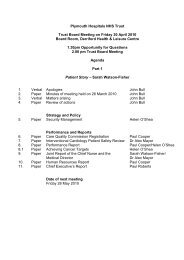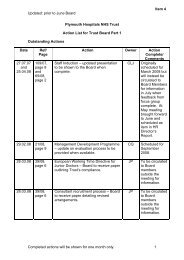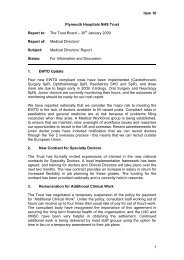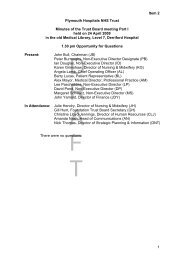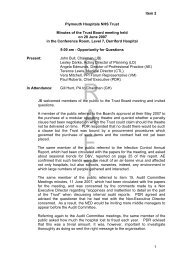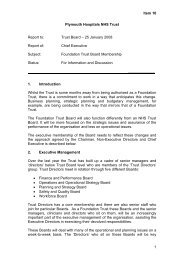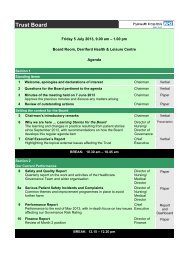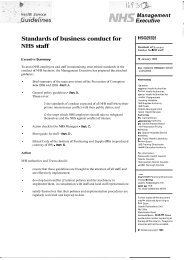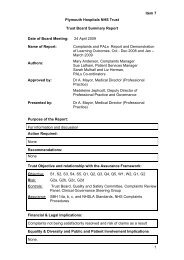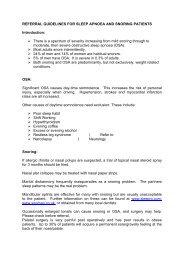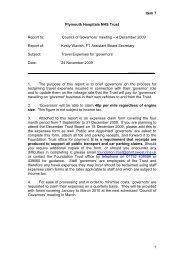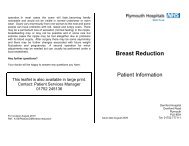Cascade Summer/Autumn 2012 - Plymouth Hospitals
Cascade Summer/Autumn 2012 - Plymouth Hospitals
Cascade Summer/Autumn 2012 - Plymouth Hospitals
You also want an ePaper? Increase the reach of your titles
YUMPU automatically turns print PDFs into web optimized ePapers that Google loves.
cascade_summer_<strong>2012</strong>_1.5:<strong>Cascade</strong>_Winter_2011 23/10/<strong>2012</strong> 13:47 Page 10<br />
10<br />
Exercise Bolivian Venture<br />
by LNN P McColgan<br />
I have recently returned from a three week Defence Medical<br />
Services (DMS) mountaineering expedition to Bolivia. The<br />
purpose of the expedition was to carry out research into changes<br />
in natriuretic hormones at high altitude, specifically how B-Type<br />
Natriuretic Peptide (BNP), Neutrophil Gelatinase Associated<br />
Lipocalin (NGAL), copeptin, vasopressin, catecholamines,<br />
aldosterone, Cortisol and Total Body Water at High Altitude relate<br />
to, and potentially predict, Acute Mountain Sickness (AMS).<br />
The research was conducted by two groups of approximately 25<br />
DMS personnel climbing peaks up to and over 6000m in the<br />
Cordillera Real range of the Bolivian Andes. Data including basic<br />
observations, blood, urine, saliva, weight and echocardiograms<br />
were taken at 3400, 4500 and 5200m. In total 2500 blood, 300 urine<br />
and 600 saliva samples were taken and are back in the freezer at<br />
Newcastle's Royal Victoria Infirmary. While over 200<br />
echocardiograms were gathered at various altitudes. 49 out of the<br />
50 participants made it to the top of Pata Patani (5500m), via a<br />
new route, while 26 made it to the top of Chacochamani (6040m)<br />
probably the first 26 non Bolivian ascents from the west side of the<br />
mountain. We climbed two unclimbed rocky summits around<br />
5200m closer to base camp, explored to high on an unclimbed<br />
peak further up the valley and a couple of the more experienced<br />
climbers made the first ascents of the east and west peaks of<br />
Jackosire a previously unclimbed peak.<br />
The final climb on Pata Patani<br />
News from around the Trust<br />
To gather the research and conduct the climbing we spent twelve<br />
days in the mountains setting up camps at various altitudes. The<br />
main camp at 4800m came with a group of inquisitive Lama’s and<br />
its very own glacial stream/outdoor bathing facilities. With the sun<br />
setting at approximately 1900 and the night time temperature of -5<br />
to -20 little was done after dark apart from sleep. The days always<br />
brought a new route to explore and breathtaking scenery to be seen.<br />
On a daily basis we were reminded that it was not a holiday. The majority of the<br />
time this was by Surgeon Commander Mellor (research lead), but the altitude and<br />
local food also took their toll with the majority suffering from AMS with varying<br />
degrees of severity. One of the group developed pulmonary oedema however this<br />
was treated and he continued on with the expedition. I myself had a two day period<br />
of illness and can assure you that O2 sats of 81% and a resting HR of 140bpm was<br />
not particularly enjoyable.<br />
However it was not all doom and gloom. During the acclimatisation phase we<br />
managed to see the sights of La Paz and visit Lake Titicaca. While the R&R period<br />
at the end of the trip allowed the majority to take part in the “Death Road” cycle.<br />
This consisted of a 65km stretch of road that drops from a height of 4500m to a<br />
finish at 1200m.<br />
All in all it was an amazing experience and one that I would thoroughly recommend<br />
to all.<br />
Research at 4200m!<br />
The sumit of<br />
Pata Patani<br />
Those who have further interested in this area can follow the link below to the DMS Expedition website.<br />
http://dmsexpeds.org.uk/



